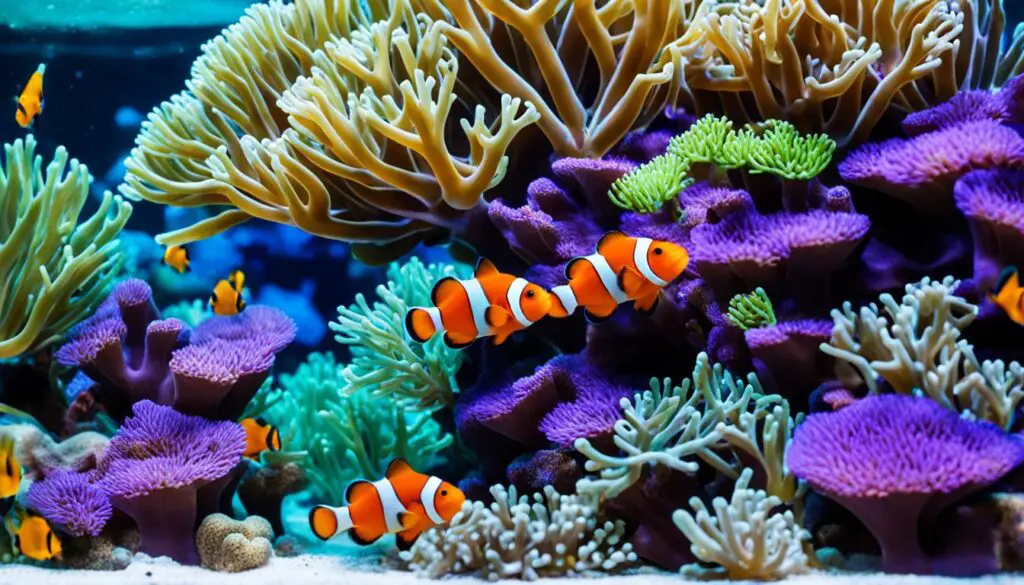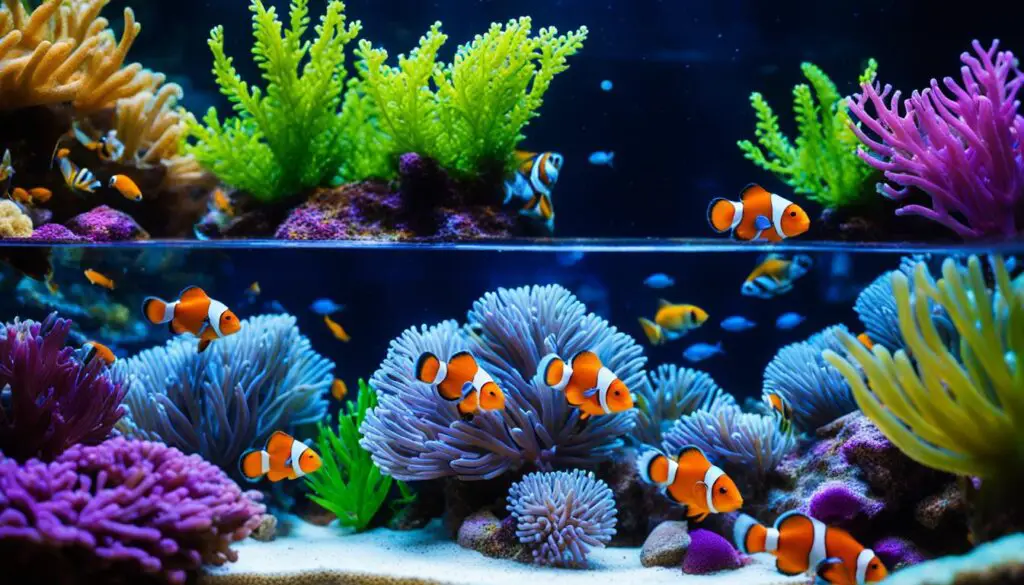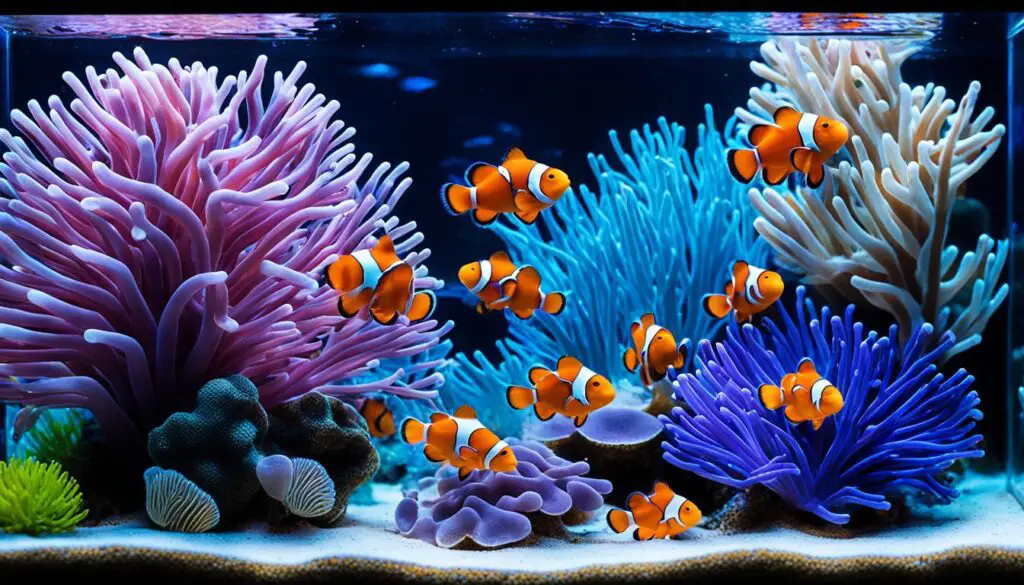Dive into Clownfish Care: The Ultimate Pet Care Guide
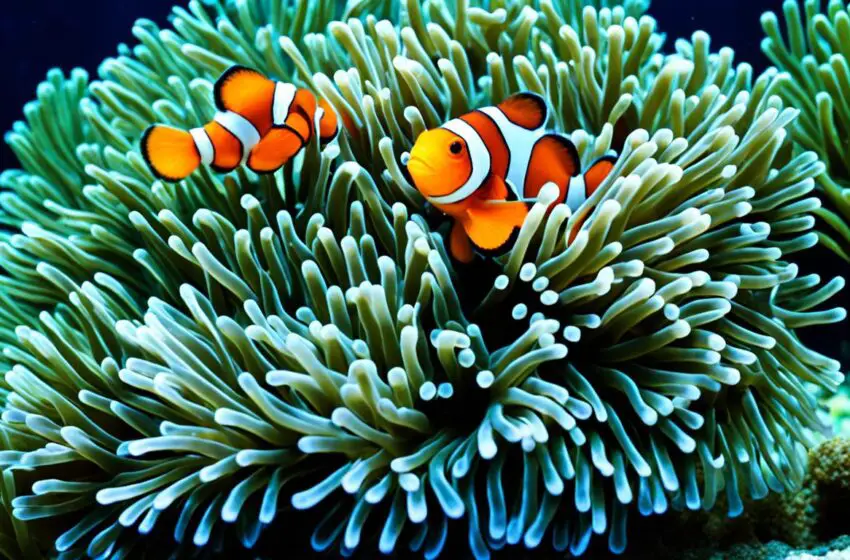
Welcome to the ultimate pet care guide for clownfish! These fish are much loved for their bright colors and fun nature, making them favorites with both hobbyists and kids. Though they are not high maintenance, it’s crucial to set up the right tank for them. This guide will walk you through everything you need to know about clownfish care. You’ll learn the best tank size, habitat tips, and much more. Let’s ensure your clownfish live happily in their home.
Key Takeaways:
- Clownfish are popular saltwater fish that are loved by hobbyists and children alike.
- They are relatively easy to care for but require specific tank conditions to thrive.
- In this guide, we will explore all aspects of clownfish care, from the ideal tank size to habitat tips.
- By following the advice in this guide, you can create a thriving home for your clownfish.
- Stay tuned for the upcoming sections where we will delve deeper into each aspect of clownfish care!
Understanding the Tank Size and Setup Requirements for Clownfish
Creating the right tank for clownfish is important for their health. I’ve gathered tips on the best tank size, setups, and what conditions they need. I’m excited to share what I know with you!
The Ocellaris Clownfish, in particular, need a tank that holds at least 20 gallons. This size allows them plenty of room to swim and act as they would in the ocean. A larger tank is ideal for their active nature and health.
It’s also key to have the right tank setup. Clownfish need good filters to keep their home stable. The right pumps and equipment make sure the water is clean and full of oxygen.
Creating a natural habitat is critical too. Adding live rocks and sand makes them feel at home and gives them places to hide and explore. This also makes your tank look great and meets their psychological needs.
Next, let’s look at the tank conditions. Regular cleaning is a big must. Keep an eye on the tank’s temperature, salt levels, and pH to make sure they’re right for your clownfish. Doing these things often will keep them in great shape.
“Providing the ideal tank size and setup for clownfish is the key to their health and happiness. A spacious aquarium, proper filtration, and a well-maintained habitat are essential for creating a thriving environment for these beautiful sea creatures.” – Me
Be patient before putting clownfish in a new tank. It’s crucial to let the environment stabilize with good bacteria first. This supports the fish’s health in the long run.
Maintaining the Ideal Tank Size and Setup for Clownfish
Here’s a quick rundown of what you’ll need for your clownfish tank:
- Choose an aquarium with a minimum capacity of 20 gallons to provide ample swimming space for clownfish.
- Invest in reliable filtration systems to maintain water quality and create a stable environment.
- Add reef structures like live rocks and sand to mimic their natural habitat and provide hiding spots.
- Regularly monitor and maintain water parameters to ensure optimal conditions for clownfish.
- Establish a stable ecosystem before introducing clownfish to the tank.
Stick to these steps, and your clownfish will love their new home. You’ll also love watching them in your aquarium.
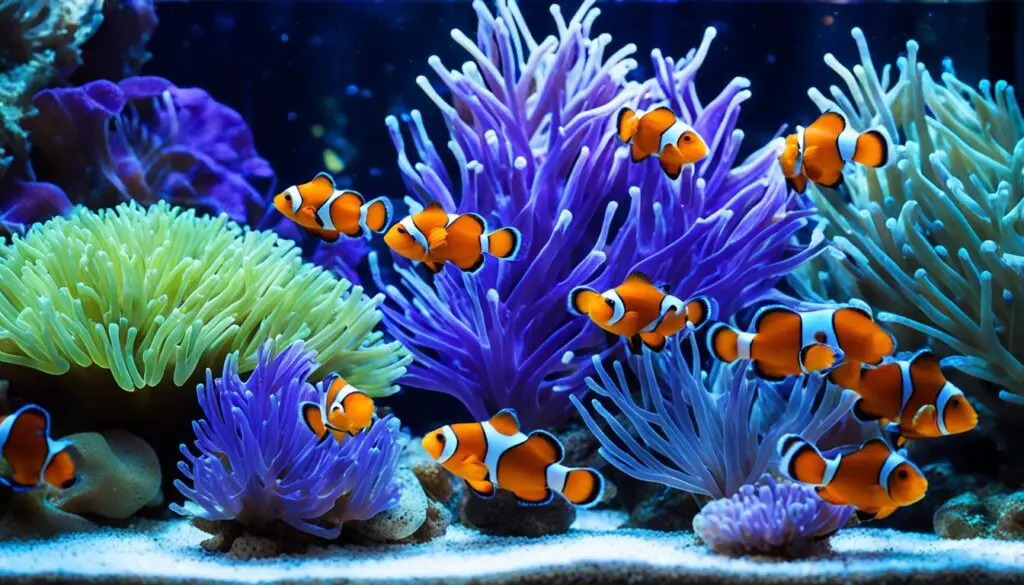
Creating the Perfect Habitat for Clownfish: Mimicking their Natural Environment
Clownfish live in a special relationship with anemones in the ocean. To keep them healthy, it’s key to make their aquarium like their home. This means adding the right anemones to give them a safe and natural place.
Finding the right anemones for clownfish is very important. Some anemones just won’t work, so you need to pick carefully. Good anemones for clownfish home include:
- Bubble Tip Anemone (Entacmaea quadricolor)
- Sebae Anemone (Heteractis crispa)
- Carpet Anemone (Stichodactyla spp.)
These anemones offer the perfect space for clownfish. They give them safety and a place to call home in your tank.
Setting up the right light and water in the tank is crucial. Anemones need strong light, so pick the best light for your tank. Also, keep the water clean and healthy for your clownfish and anemones. Check the water often for things like temperature, salt, and pH.
Below, we’ve added a picture to make your article look amazing. It shows the beauty of clownfish and anemones living together:
Having clownfish and anemones together makes a beautiful tank. It’s not just nice to look at. It keeps your clownfish happy and healthy too.
Feeding and Care for Clownfish: Providing Optimal Nutrition and Maintenance
Taking care of clownfish well is very important. They eat both meat and plants, so it’s vital to feed them a variety of foods. This will make sure they get all the nutrients they need and stay content.
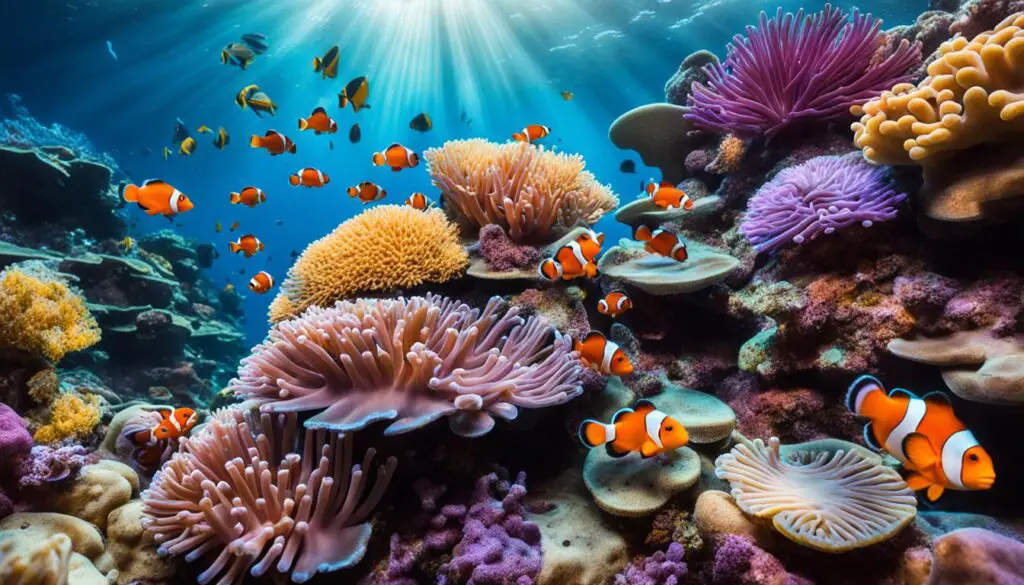
Start by feeding them with special fish foods you can buy. Look for ones made for saltwater fish that have lots of nutrients. This makes sure they have a healthy diet.
Other than dry foods, fresh or frozen foods are also great for clownfish. Things like brine shrimp and mysis shrimp are perfect. They’re like what clownfish eat in the ocean and are very nutritious.
Sometimes, you can give them extra treats like bloodworms. But, remember not to give too many, as they can be fatty. A balanced diet is the key to their good health.
“I recommend feeding my clownfish a combination of commercial fish food, live or frozen foods like brine shrimp, and occasional treats like bloodworms. This ensures they receive a diverse range of nutrients for optimal health.” – Zoe Anderson, Clownfish Enthusiast
Tank Maintenance for Clownfish
Keeping the tank clean is crucial for your clownfish’s wellbeing. You should regularly check the water’s temperature, salt levels, and acidity.
Changing some of the water every few weeks is a must. This removes dirt and harmful chemicals. Shoot for about a 10-15% water change. It keeps the water safe and helps your fish avoid sickness.
Good filters are also key for a healthy tank. A protein skimmer and a biological filter are great for keeping the water clean. Be sure to clean them often to keep them working well.
“To provide the best care for my clownfish, I regularly monitor water parameters, perform routine water changes, and clean and maintain my filtration systems. This helps create a clean and stable habitat for them to thrive in.” – Zoe Anderson, Clownfish Enthusiast
| Feeding Tips for Clownfish | Tank Maintenance Tips for Clownfish |
|---|---|
| Offer a variety of food options, including commercial fish food, live or frozen foods like brine shrimp, and occasional treats. | Monitor water parameters regularly, including temperature, salinity, and pH levels. |
| Avoid overfeeding and provide a balanced diet to prevent health issues. | Perform regular water changes to maintain water quality and reduce the risk of stress or disease. |
| Remove any uneaten food to prevent water pollution. | Use a high-quality protein skimmer and biological filter to remove waste and maintain optimal water conditions. |
Conclusion
Clownfish are a great choice for your aquarium. They are easy to care for. They are also sturdy and offer a nice learning experience for kids. Setting up the right tank, creating their ideal living space, and giving them good food will make them thrive.
Remember, clownfish need at least 20 gallons to live happily. You also need to have the right filters and structures in their tank. This keeps them healthy.
To make your tank just right for clownfish, copy their ocean home. Pick anemones that go with them and keep their tank well-lit and clean. This creates a happy place for them to live.
Taking care of what they eat and their environment is essential for their health. They should eat a mix of foods, such as regular fish food and treats. Keep their water clean and check it often.
Make sure their home stays safe and clean. That way, your clownfish will be happy. Enjoy taking care of them and watching them grow!
FAQ
What is the ideal tank size for clownfish?
Clownfish need a tank that’s at least 20 gallons. This allows them enough room to swim freely.
What are the tank setup requirements for clownfish?
To keep clownfish happy, you’ll need proper filtration and pumps. They also love reef structures, such as live rock and sand. Before you get them, make sure the tank is fully settled. Regular cleaning and care are also a must.
Do clownfish need anemones in their tank?
Clownfish and anemones share a special bond in nature. While not a must, having anemones in the tank can make your clownfish feel at home. They provide a safe space and mirror their natural habitat.
What should I feed my clownfish?
Clownfish eat both plant and animal foods. Give them a mix of commercial fish food, live brine shrimp, and occasional bloodworms. Varying their diet keeps them healthy and happy.
How do I maintain my clownfish tank?
To upkeep your clownfish’s home, check the water quality often. Do regular water changes and keep your filter working well. A clean tank environment is also important for their health.

